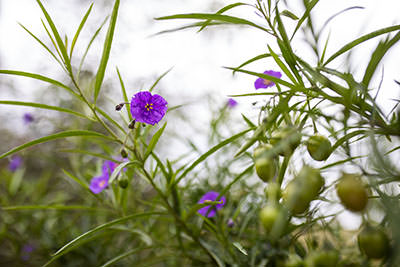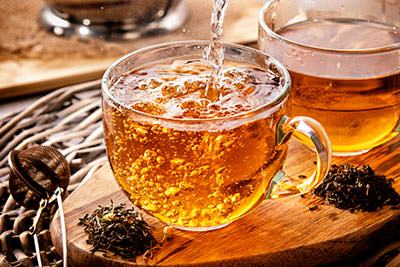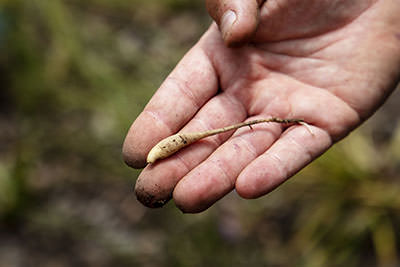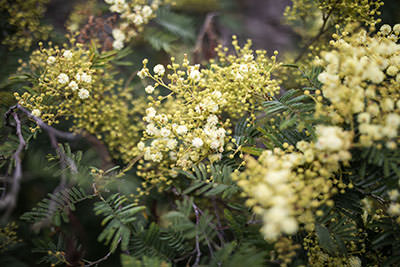LEARNING ACTIVITY
STORY
When Jarrah and Adam went on their walk, they could see lots of plants used for food, fibre, medicines. Adam talked about the different parts of the plant that were eaten, and if it was the leaves, roots, flowers, fruits and or seeds. Jarrah was very interested and amazed at how much food was in the bush!
Jarrah then came across a beautiful large plump purple fruit on a small strappy plant. He was so excited and picked it and popped it in his mouth. He then spat it out. “Yuck!” he cried, “that was awful”.
Adam came over. “Jarrah, we don’t just go and eat any old fruit in the bush, some can be harmful. This one is what the women in our families used to dye their dilly bags but is not for eating. You’re lucky that it’s just awful tasting and not toxic like some fruits can be”.

For thousands of years, First Nations peoples across Australia have been using plants for many different purposes. Plants are used for food, fibre, shelter, medicine, tools and utensils, hunting, music and ceremony. Everything they needed to survive comes from the land.
To understand local perspectives and support these activities, we recommend reaching out to the local Traditional Owners and First Nations peoples who can assist in knowledge sharing and understanding local land, histories and culture. This is an important consideration to ensure that any reconciliation initiatives are being driven in a local, meaningful way.
This learning activity is the first part of a sequence of 6 individual learning activities focused on creating an Indigenous plant-use garden. The order of these learning activities are: resources from the bush, vision, plant list, site assessment, planting and harvesting.
For children to:
- appreciate the diverse range of plants that First Nations peoples across Australia use
- explore the different ways that Indigenous plants are used, e.g. food, fibre, medicine, tools, utensils, ceremony and in everyday life
- identify plants from their local area using plant guides.
This activity can be undertaken any time of the year, however it is important to remember that the reproductive cycle of plants is dependent on the time of the year, and the climate zone of the area. You may like to repeat this activity at different times of the year to see the difference in the plants.
Introduction
This activity explores the importance of plants for Aboriginal and Torres Strait Islander peoples who know and understand the plants, life cycles, seasons, and the different ways plants are used. Care must be taken when interacting with plant materials. Correct plant identification is crucial to knowing which plants are edible and which are best to avoid.
This is a great opportunity to invite your local Traditional Owners take you on a guided walk so they can share their deep knowledge, connection and understanding of the land, stories and culture specific for your area. This is also a great way for starting to build relationships with your local First Nations community for the future, and take action towards reconciliation. Growing your garden will grow these partnerships even further.
*Time allocation will be dependent on site selection and travel time. Learners may visit bushland or look at native plants in the school garden, local park or reserve.
Checklist
Instructions
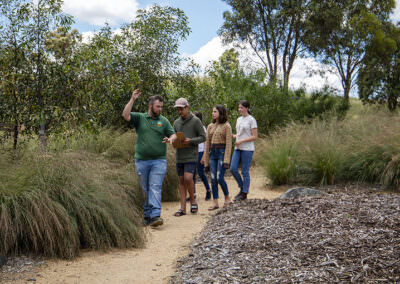
STEP 1
Preparing
For many thousands of years, Aboriginal and Torres Strait Islander peoples have depended on the bush for everything they needed to survive.
The materials that a plant provided would depend on the different times of the year. Different parts of a plant were used for a variety of purposes. The different plant parts used included the root, leaf or shoot, flower, fruits, seeds, stems or wood.
Before you go on your walk, you may like to explore some of the field guides and resources. Using the Aboriginal and Torres Strait Islander Plant use in South Eastern Australia and Aboriginal and Torres Strait Islander Plant use and technology (or a local guide for plants local to your area) will help you to identify some of the plants on your walk and what they are used for.
Having a First Nations person guide you on your walk is even better as they can explain how the plants are used and share stories and culture.

STEP 2
Exploring
Begin this activity at your location with an Acknowledgement of Country. By acknowledging the Land, you are also making a promise that you will care for the Land, the waterways, the plants and the animals.
Complete the Whose Country are you on? learning activity to determine your local First Nations language group.
Explore a bushland area close by and complete the activity sheet by drawing the different plant parts that you found on your walk. You may also like to take photos.
While you are on your walk, use your senses to observe your surroundings. What do you see, smell, hear, feel?

STEP 3
Observing
Dependent on the time of year, you may not see flowers, fruits or seeds. Look for examples of seed pods, dried fruits or flowers on the ground.
If you haven’t seen any flowers, fruits or seeds, think about how other parts of the plants (bark and the wood) may be used.
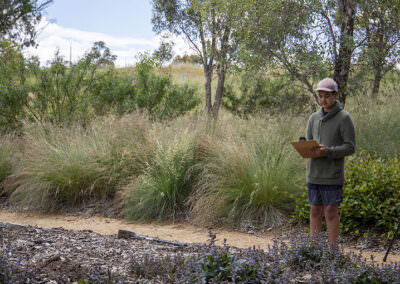
STEP 4
Identifying
Using the plant field guides or online resources in the resource list, identify the plants that you have observed and recorded in your activity sheet.
This is a great time to consider if any of these plants would be suitable to include in your plant-use garden.
Research further information about the plants observed and how they can be used as food and fibre. Complete the activity sheet, write about the food and fibre use and include a climate zone. The climate zone will help determine its suitability for your location.
Make sure you ask questions of your guide to help increase your understanding and knowledge.
Extension Activity
Extension 1
Using the plants included in the plant list activity in this series, create your own plant identification guide or informative sign. Use scientific names and common names and the name in the local First Nations peoples language if you are able. Describe what the plants look like, how they are used and include images of the different plant parts to make it easier to identify.
Extension 2
Explore the effect of European settlement on the availability of plants for use by the First Nations peoples. How did the introduction of hard hooved animals such as cattle and sheep change the landscape for First Nations peoples?
Curriculum and Framework Links
Check the curriculum authority for your state or territory for Aboriginal and Torres Strait Islander specific subjects. This may also include training organisations.
GEOGRAPHY
Year 7: ACHGK045
Year 8: ACHGK049
Year 9: ACHGK061, ACHGK062, ACHGK064, ACHGK067
Year 10: ACHGK070, ACHGK071, ACHGK072, ACHGK076
HISTORY
Year 7: ACOKFH003, ACDSEH031
Year 9: ACDSEH085, ACDSEH020
DESIGN & TECHNOLOGIES
Years 7 & 8: ACTDEK032, ACTDEK033
SCIENCE
Year 7: ACSSU112, ACSSU116, ACSHE223, ACSHE121
Year 8: ACSHE134, ACSHE226
Year 9: ACSSU176
VISUAL ARTS
Years 7 & 8: ACAVAM118, ACAVAR124
Years 9 & 10: ACAVAM125, ACAVAR131
EARTH & ENVIRONMENTAL SCIENCES
Year 11: ACSES011, ACSES040
Year 12: ACSES066, ACSES077, ACSES081
BIOLOGY
Year 11: ACSBL011, ACSBL019, ACSBL020, ACSBL009, ACSBL011
GENERAL CAPABILITIES
Critical and Creative Thinking
Personal and Social Capability
Ethical Understanding
Intercultural Understanding
CURRICULUM CONNECTIONS
Outdoor Learning
CROSS CURRICULUM PRIORITY
Aboriginal and Torres Straight Islanders Histories and Cultures
Sustainability
Reference List
ONLINE RESOURCES
Aboriginal and Torres Strait Islander Plant use in South Eastern Australia and Aboriginal and Torres Strait Islander Plant use and technology, from the Australian National Botanic Gardens provides some insightful and educational information that will assist in completing this learning activity.
The Care for Country RAP (Reconciliation Action Plan) Action and Caring for country (Secondary) curriculum resource on the Narragunnawali platform provides resource material for students and teachers to build a personal sense of responsibility for respecting and caring for the Country/place around them, the while building an awareness and appreciation of Aboriginal and Torres Strait Islander contributions to sustainable land management.
WATCH
This collection of videos from Gardening Australia looks at Aboriginal and Torres Strait Islander plant use. Sharing the Knowledge (7 minutes), Bush Foods (4 minutes) Aboriginal Heritage Plants (5 minutes 30).
Keeping culture alive from ABC Education shows First Nations peoples city children taken on a trip to the country to find out how to make a didgeridoo, use bush medicine and what plants and insects can provide food. (3 minutes 30).
Discovering past methods of food and fibre production from FUSE (State of Victoria Department of Education and Training) looks at the native food plants of the Mount Gambier region in South Australia and how they were used by the local Buandig people.(5 minutes).
READ
Guide books for your local area.
Field guide to useful native plants from temperate Australia by Judith Caton & Richard Hardwick, Harbour Publishing House, 2016 provides very useful visual information along with growing conditions and First Nations peoples uses for plants in temperate areas.
This selection of books gives more detailed information on Australian native plants, their traditional uses and modern uses and recipes.
- The oldest foods on Earth, John Newton 2019 published by NewSouth Publishing
- Grow your own bushfoods, Keith and Irene Smith, 2013 New Holland Publishers
- Australian Native Food Harvest, Julie Weatherhead, 2016 published by Peppermint Ridge Farm.
NETWORK
We recommend reaching out to your Local Traditional Owners and First Nations peoples community groups who can assist in knowledge sharing and understanding local land, language, stories and culture. To reach out or find contacts in your local community you could speak to parents of First Nations students, to an Indigenous Learning Officer (ILO) at your school, local Land Council or a local Landcare group. Engaging with these resources can contribute to a wider school and community reconciliation initiatives, including a schools Reconciliation Action Plan (RAP).
We have some suggested organisations to approach listed on our Junior Landcare Community Page and in more detail within our Educator Notes.
Why not try one of our other Junior Landcare learning activities?
Creating an Indigenous plant-use garden: plant list
First Nations Perspectives
Love Letters to the Land
Biodiversity|First Nations Perspectives|Food Production|Waste Management
Creating a yarning circle: involving First Nations people
First Nations Perspectives
Creating a yarning circle: yarning circle activities
First Nations Perspectives
